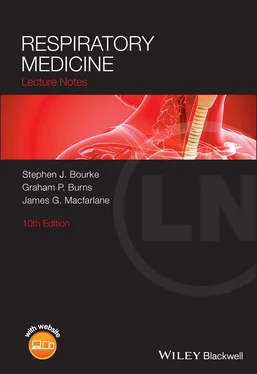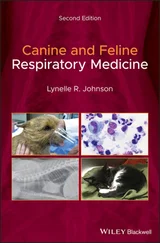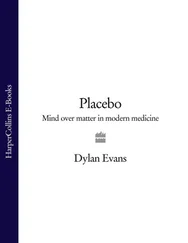1 ...7 8 9 11 12 13 ...25 3 1.3 BAirway resistance in health resides principally in the central (large) airways at high lung volume (‘You only have one trachea’). As lung volume decreases, the site of greatest resistance moves peripherally to the smaller airways (their calibre diminishes). It is increased in emphysema and is proportional to r4. Increasing effort WILL lead to increased expiratory flow, but only up to a certain point, beyond which ‘peak flow’ cannot be increased no matter what the effort.
4 1.4 DGas exchange is driven by diffusion and therefore dependent on bringing the air and blood together (V/Q matching). Most of the ventilation goes to the bases, but an even greater proportion of the perfusion goes to the bases. Poor V/Q leads to a fall in PO2 but does not affect PCO2. Reduced overall ventilation causes a rise in PCO2 and a fall in PO2.
5 1.5 BThis is elevated, implying a problem with VQ matching within the lung.
6 1.6 ADuring inspiration, the diaphragm contracts and stiffens, pushing the abdominal contents down and reducing pressure in the thorax, which ‘sucks’ air in. Expiration is a relatively passive reversal of the process.
7 1.7 CReducing ventilation means less CO2 is ‘blown off’ (leading to a rise in PACO2 and PaCO2). If fresh air isn’t brought into the lungs then alveolar oxygen will not be replenished, PAO2 will fall and so must PaO2.
8 1.8 ESee Figure 1.11.
9 1.9 CThe sensitivity to changes in pH and pCO2 is so exquisite that adjustments are made before any measurable change can occur. Hypoxia does matter, but only has significant impact on the drive to breathe when pO2 falls significantly (approx. 8 kPa). A low pH can be caused by either reduced ventilation or a metabolic disturbance (in which case, it would lead to a rise in ventilation). Increased ventilation will increase PAO2 and therefore PaO2 though it won’t increase the oxygen content of the blood (much) as arterial blood is ordinarily close to fully saturated.
10 1.10 BAs lung volume is reduced, the small airways narrow and the site of principal resistance moves peripherally (i.e. to the smaller airways). Resistance is lowest (and therefore max forced flow rate is achieved) when the lungs are full. FEF25–75 provides information on the calibre of the small airways, but it can be a rather noisy signal.
Part 2 History taking, examination and investigations
2 History taking and examination
History taking
History taking is of paramount importance in the assessment of a patient with respiratory disease. Difficult diagnostic problems are more often solved by a carefully taken history than by laboratory tests. It is also during history taking that the doctor gets to know the patient and their fears and concerns. The relationship of trust thus established forms the basis of the therapeutic partnership.
The doctor should start by asking the patient to describe their symptoms in their own words. Listening to the patient’s account of the symptoms is an active process, in which the doctor is seeking clues to underlying processes, judging which items require further exploration and noting the patient’s attitude and anxieties. By carefully posing questions, the skilled clinician directs the patient to focus on pertinent points, to clarify crucial details and to explore areas of possible importance. History‐taking skills develop with experience and with a greater knowledge of respiratory disease.
It is important to appreciate the differences between symptoms, which are a patient’s subjective description of a change in the body or its functions that might indicate disease; signs, which are abnormal features noted by the doctor on examination; and tests, which are objective measurements undertaken at the bedside or in the diagnostic laboratory. Thus, for example, a patient might complain of pain on breathing, the doctor might elicit tenderness on pressing on the chest and an X‐ray might show a fractured rib.
Table 2.1lists the main respiratory symptoms that might be encountered in history taking.
Dyspnoea (breathlessness) is something everyone understands but no one can satisfactorily define. It is a subjectivesensation and thus as much about the mind’s interpretation of the signals it receives from the body as about what’s going on in the lungs. Dyspnoea is an unpleasant sensation, an awareness of breathingthat seems inappropriately difficultfor the demands that have been placed upon the body. It is not tachypnoea (increased respiratory rate), which is a sign noted by the doctor. For example, an athlete at the end of a modest training run will be tachypnoeic but is unlikely to complain of breathlessness.
In history taking, when attempting to determine the cause of dyspnoea, careful assessment includes taking note of the speed of onset, progression, periodicity and precipitating/relieving factors. The severity of dyspnoea is graded according to the patient’s exercise tolerance (e.g. dyspnoeic on climbing a flight of stairs or at rest). Onset may be sudden, as in the case of a pneumothorax, or gradual and progressive, as in chronic obstructive pulmonary disease (COPD). An episodic dyspnoea pattern is characteristic of asthma, with symptoms typically being precipitated by cold air or exercise and often displaying diurnal variability(varying with the time of day). Orthopnoeais dyspnoea that occurs when lying flat and is relieved by sitting upright. It is a characteristic feature of pulmonary oedema or diaphragm paralysis but can be found in most respiratory diseases if very severe. Paroxysmal nocturnal dyspnoea(PND) is the phenomenon of waking up breathless at night. Most medical students assume this implies pulmonary oedema, but it is also a cardinal feature of asthma. An exploration of other features of these two conditions is needed before a conclusion about cause can be drawn.
Table 2.1 Main respiratory symptoms
| Dyspnoea (Breathlessness)WheezeCoughSputumHaemoptysisChest pain |
It is important to note what words the patient uses to describe the symptoms: ‘tightness in the chest’ may indicate breathlessness or angina. Dyspnoea is not a symptom that is specific to respiratory disease and it may be associated with various cardiac diseases, anxiety, anaemia and metabolic states such as ketoacidosis.
This is a whistling or musical noise that is characteristic of air passing through a narrow tube. The sound of wheeze can be mimicked by breathing out almost to residual volume and then giving a further sharp, forced expiration. Wheeze is a characteristic feature of airway obstruction. It is seen in asthma. In theory, it might be expected in COPD but is rarely found in practice. In COPD, auscultation is more likely to reveal diminished (quiet) breath sounds. It can also occur in pulmonary oedema when airway walls are swollen with fluid. In asthma, wheeze is characteristically worse on waking in the morning and may be precipitated by exercise or cold air. Wheeze that improves at weekends or on holidays away from work and deteriorates on return to the work environment is suggestive of occupational asthma. Wheeze occurs on expiration. ‘Wheeze’ on inspiration is not wheeze, it is stridor– indicating obstruction of the central airways (e.g. obstruction of the trachea by a carcinoma): an important distinction not to miss.
When wheeze is present, airway obstruction is present. Wheeze, however, is not a reliable indicator of obstruction. It is often absent in COPD and severe, life‐threatening asthma may be associated with a ‘ silent chest’.
Читать дальше











